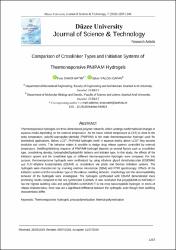| dc.contributor.author | Hatır, Pınar Çakır | |
| dc.contributor.author | Capan, Özlem Yalçın | |
| dc.date.accessioned | 2023-04-12T08:31:31Z | |
| dc.date.available | 2023-04-12T08:31:31Z | |
| dc.date.issued | 2019 | en_US |
| dc.identifier.citation | HATİR, P. C., & CAPAN, O. Y. Sıcaklığa Duyarlı PNIPAM Hidrojellerde Çapraz Bağlayıcı ve Başlatıcı Sisteminin Karşılaştırılması. Düzce Üniversitesi Bilim ve Teknoloji Dergisi, 7(3), 1237-1248. | en_US |
| dc.identifier.issn | 2148-2446 | |
| dc.identifier.uri | https://doi.org/10.29130/dubited.544824 | |
| dc.identifier.uri | https://hdl.handle.net/20.500.12294/3735 | |
| dc.description.abstract | Thermoresponsive hydrogels are three-dimensional polymer networks which undergo conformational changes in
aqueous media depending on the external temperature. As the lower critical temperature (LCST) is close to the
body temperature, poly(N-isopropylacrylamide) (PNIPAM) is the main thermoresponsive hydrogel used for
biomedical applications. Below LCST, PNIPAM hydrogels swell in aqueous media, above LCST they become
insoluble and shrink. This behavior makes it possible to design drug release systems controlled by external
temperature. Swelling/shrinking response of PNIPAM hydrogel depends on several factors such as crosslinker
type, crosslinking density, hydrophobic/hydrophilic balance and initiator type. In this study, the effects of the
initiation system and the crosslinker type on different thermoresponsive hydrogels were compared. For this
purpose, thermoresponsive hydrogels were synthesized by using ethylene glycol dimethylacrylate (EGDMA)
and N,N′-ethylene bisacrylamide (EBAM) as crosslinkers via photo and thermal initiation systems. The
hydrogels were characterized by scanning electron microscope (SEM) and FTIR spectroscopy. Effects of the
initiation system and the crosslinker type on the release, swelling behavior, morphology and the biocompatibility
behavior of the hydrogels were investigated. The hydrogels synthesized with EBAM demonstrated more
promising results compared to the one synthesized EGDMA. It was concluded that poly(EBAM-co-NIPAM)-P
has the highest swelling ratio and poly(EBAM-co-NIPAM)-T is the most biocompatible hydrogel. In terms of
release characteristics, there was not a significant difference between the hydrogels, even though their swelling
characteristics differ. | en_US |
| dc.language.iso | eng | en_US |
| dc.publisher | Düzce Üniversitesi Fen Bilimleri Enstitüsü | en_US |
| dc.relation.ispartof | Düzce Üniversitesi Bilim ve Teknoloji Dergisi | en_US |
| dc.identifier.doi | 10.29130/dubited.544824 | en_US |
| dc.rights | info:eu-repo/semantics/openAccess | en_US |
| dc.subject | Thermoresponsive Hydrogels | en_US |
| dc.subject | Photopolymerization | en_US |
| dc.subject | Thermal Polymerization | en_US |
| dc.title | Comparison of Crosslinker Types and Initiation Systems of Thermoresponsive PNIPAM Hydrogels | en_US |
| dc.type | article | en_US |
| dc.department | Mühendislik ve Mimarlık Fakültesi, Biyomedikal Mühendisliği Bölümü | en_US |
| dc.authorid | 0000-0002-3806-7118 | en_US |
| dc.authorid | 0000-0002-7511-3355 | en_US |
| dc.identifier.volume | 7 | en_US |
| dc.identifier.issue | 3 | en_US |
| dc.identifier.startpage | 1237 | en_US |
| dc.identifier.endpage | 1248 | en_US |
| dc.relation.publicationcategory | Makale - Ulusal Hakemli Dergi - Kurum Öğretim Elemanı | en_US |
| dc.institutionauthor | Hatır, Pınar Çakır | |
| dc.institutionauthor | Capan, Özlem Yalçın | |


















